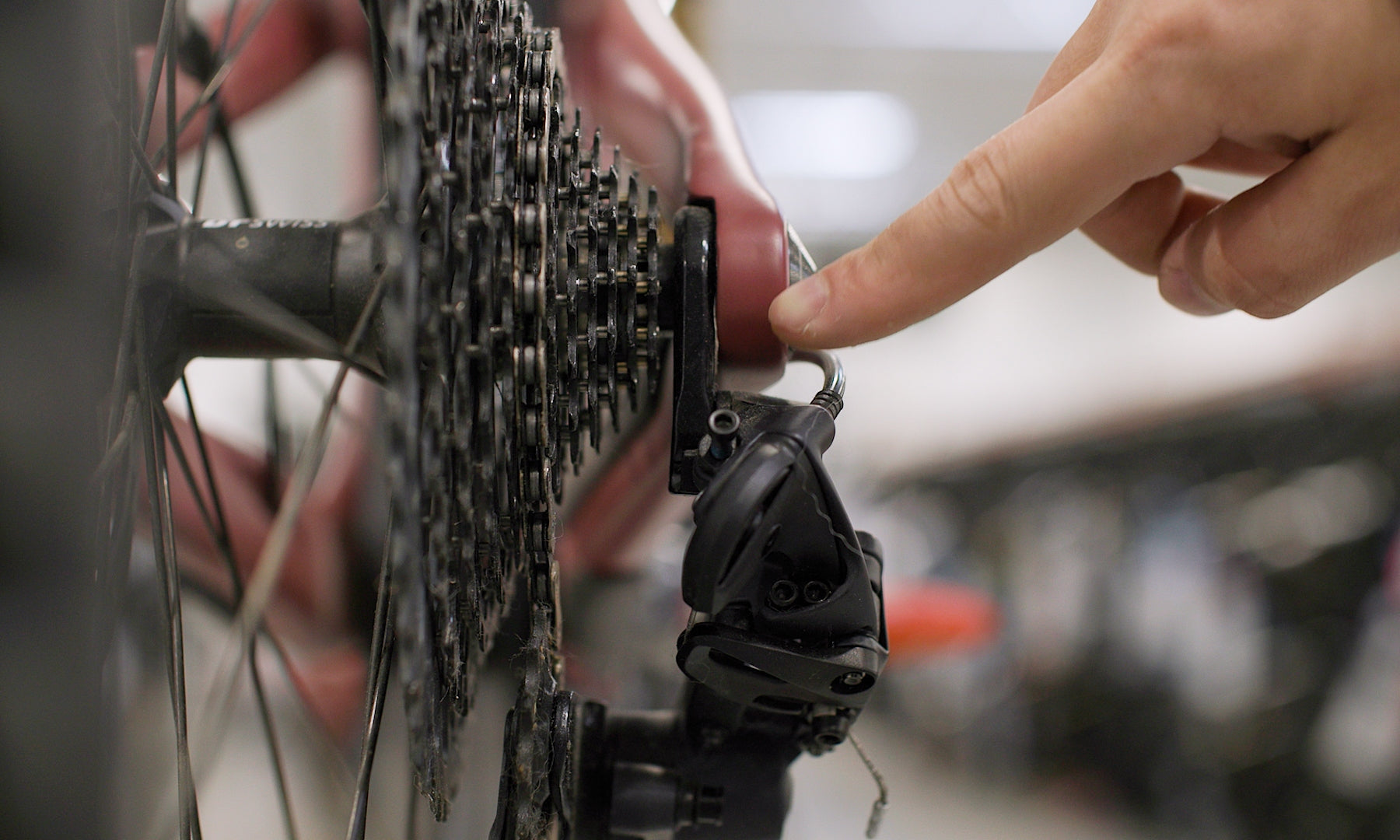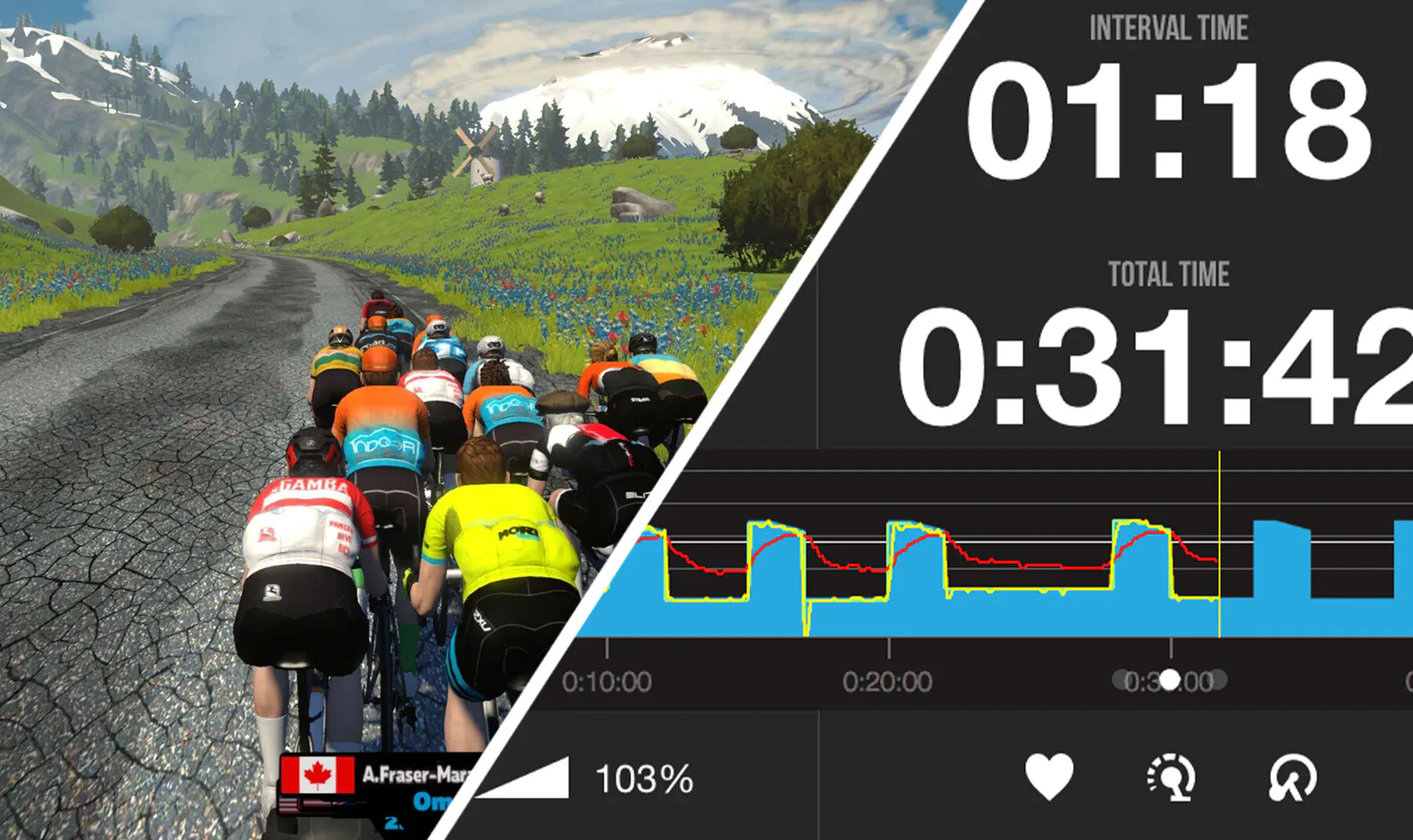Is your rear derailleur not shifting as well as you’d like? To get it feeling crisp and precise, there are 3 main adjustments that you can use to fine-tune your mechanical rear derailleur:
- Indexing (cable tension)
- B-Gap or B-Tension
- High and Low Limit
We’ll cover the basics of what each adjustment does, and what symptoms these adjustments can help remedy.
[button]Shop Bikes[/button]
Tools needed
 Using a hex wrench and SRAM b-gap tool.
Using a hex wrench and SRAM b-gap tool.
- Hex wrenches
- B-Gap / B-Tension measuring tool (optional)
[product-block handle="park-tool-professional-hex-wrench-set-hxs-1-2"/]
Standard hex wrenches are usually all you need to adjust and tune most modern rear derailleurs. The most common sizes needed are 2mm (Shimano) or 3mm (SRAM). Depending on your specific derailleur, you may need other sizes. If you have a bike-specific multi-tool, that will work!
There are tools that allow you to easily adjust or set your b-gap, but it can also be measured using a ruler or calipers (more below). This isn’t required on some Shimano derailleurs (usually MTB), which have a mark on the back of the pulley cage that helps you set the B-gap without a measuring tool.
Some older rear derailleurs may use Phillips head bolts for the high and low limit and B-gap adjustment screws.
[button]Shop Bike Tools[/button]
Rear Derailleur Indexing Adjustment
What it does
Indexing refers to your rear derailleur being lined up properly with the cogs of your cassette. It is controlled by a barrel adjuster that increases or decreases the tension of your rear derailleur cable.

On road and gravel bike derailleurs, this barrel adjuster is usually located where the rear derailleur cable meets the rear derailleur.

On mountain bikes, it’s usually located where the rear derailleur cable meets the shifter on the handlebars.
Turning the barrel adjuster increases or reduces cable tension. Too much cable tension makes it harder for the rear derailleur to shift into the smaller cogs/harder gears. Too little cable tension makes it harder for the rear derailleur to shift into the bigger cogs/easier gears. The idea is to find the right balance.
What it fixes
- The drivetrain hesitates or struggles to shift up or down into certain gears
How to adjust and tune it
- If your rear derailleur struggles or is slow to shift into a smaller cog, turn the barrel adjuster clockwise to reduce cable tension.
- If your rear derailleur struggles or is slow to shift into a bigger cog, turn the barrel adjuster counter-clockwise to increase cable tension.
Tips
- Indexing and cable tension are easiest to check and adjust by shifting back and forth between two cogs
[button]Learn More About Indexing[/button]
Rear Derailleur B-Gap / B-Tension Adjustment
What it does
 The b-gap screw is usually found where the rear derailleur mounts to the derailleur hanger on the frame. It presses against a knuckle on the derailleur hanger to adjust the b-gap.
The b-gap screw is usually found where the rear derailleur mounts to the derailleur hanger on the frame. It presses against a knuckle on the derailleur hanger to adjust the b-gap.

The b-gap screw controls the vertical distance between the rear derailleur and the cassette. If there isn’t enough b-gap, the upper pulley wheel on the rear derailleur will contact the cassette. If there’s too much, it can cause sloppy, slow, or inconsistent shifts.
What it fixes
- Slow, notchy, or inconsistent shifts
- Resistance or grinding when shifting into bigger cogs/easier gears
How to adjust and tune it
- Find the b-gap measurement for your derailleur
- Tighten the b-gap screw to increase the b-gap measurement to the correct spec
- Loosen the b-gap screw to reduce the b-gap measurement to the correct spec
- For SRAM derailleurs, you can use a SRAM b-gap tool
[button]Find the B-Gap Measurement for Your Derailleur[/button]
Rear Derailleur High and Low Limit Adjustment
What it does
 On this SRAM derailleur, the high limit screw is on the left and low limit on the right.
On this SRAM derailleur, the high limit screw is on the left and low limit on the right.
The high and low limit screws are a pair of screws that are usually near each other on the back of the rear derailleur body. They might be side by side, or they might be separated by part of the derailleur body. They’re usually low on the derailleur, and the screw heads face the rear of the bike.
As the name implies, the high and low limit screws set the upper and lower limits of the rear derailleur’s range. When set properly, the limit screws prevent the rear derailleur from shifting the chain off the end of the cassette and into your spokes or frame. It’s essential that they are set properly to prevent damage to your bike while riding.
What it fixes
- The chain shifts off the cassette and into your spokes or frame
- You can’t shift into the biggest cog/easiest gear
- You can’t shift into the smallest cog/hardest gear
Identify which screw is the high limit and which is the low limit
Some rear derailleurs mark which is the high and which is the low limit screw with an “H” and “L.” If your derailleur doesn’t have these markings, you’ll need to do a bit of investigating because there are a lot of different derailleur designs.
It’s usually easy to tell which screw is which by shifting/moving the rear derailleur into the smallest and biggest cogs, looking at where the screws enter the derailleur body, and seeing if one of the screws is contacting a stop (a metal tab) inside the derailleur.
If you shift into the smallest cog/hardest gear, the high limit screw will be bottomed out (or nearly bottomed out) against the stop while the low limit screw won’t be touching anything. If you shift into the biggest cog/easiest gear, you’ll see the opposite — the low limit screw will be bottomed out (or nearly bottomed out) against the stop in the derailleur and the high limit screw won’t be touching anything.
How to adjust and tune it
 Adjusting the high limit in the smallest cog.
Adjusting the high limit in the smallest cog.
High limit

- Shift into the smallest cog/hardest gear
- If your chain shifts too far off the cassette, tighten the high limit screw until it stays on the smallest cog
- If your chain can’t shift into the smallest cog (check your indexing first - see above), loosen the high limit screw until it can
Low limit

- Shift into the biggest cog/easiest gear
- If your chain shifts off the cassette, tighten the low limit screw until it stays on the biggest cog
- If your chain can’t shift into the biggest cog (check your indexing first - see above), loosen the low limit screw until it can
Tips
- Turn the limit screws a little bit at a time, in ¼ turn increments
- An easy method for setting the high or low limit is to tighten the screw until the chain starts to make noise or it shifts to the next cog. Then loosen it just until the noise goes away or the chain shifts back.
What If Your Shifting Still Sucks? Try Hanger Alignment
What it does
 This hanger is clearly bent.
This hanger is clearly bent.
The derailleur hanger hangs off the rear of your bike frame. It is the part the rear derailleur bolts into. If you crash, your bike falls over on its side, or you bump the rear derailleur into something, it’s possible to bend the derailleur hanger out of alignment with your cassette cogs which will affect your shifting.
What it fixes
- A bent derailleur hanger
- Inconsistent shifts at one end of the cassette but not the other
- Your derailleur going into your wheel spokes
How to adjust
The best practice is to use a hanger alignment tool — a specialized tool for straightening and aligning bent derailleur hangers. They are fairly expensive, and many home mechanics won’t have one. You can buy one, or have a bike shop straighten your hanger for you.
[product-block handle="7346317033664-wheels-manufacturing-universal-derailleur-hanger"/]
Sometimes, it’s cheaper and easier to buy a replacement derailleur hanger. You will need to find the specific hanger for your bike frame.
[button]Learn More About Fixing Bent Derailleur Hangers[/button]













